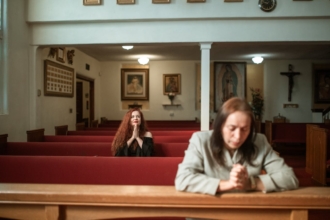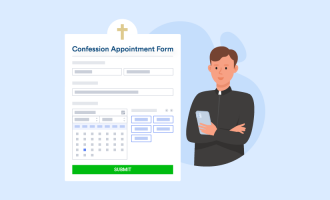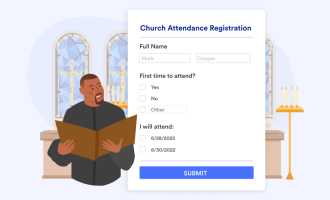Online preaching used to be reserved for the country’s megachurches. Now even the smallest churches can use technology to communicate with their congregations online.
Delivering sermons digitally is especially important with the current pandemic and social distancing guidelines. You may not be able to welcome your congregation into your church right now, but you can still educate and nurture your flock.
Here’s everything you need to know about how to use technology to deliver sermons online, stay in touch with congregants remotely, and perform administrative and fundraising duties.
Start by setting up your tech stack
You can’t deliver an online sermon if you don’t have the right technology in place. You don’t need much equipment to get started, writes videographer Paul Clifford, M.Div., author of The Serving Church.
At a minimum, you’ll need a computer to stream on, a camera to capture the video, good broadband, and an audio system. You’ll also need a streaming platform to ensure your internet doesn’t crash if hundreds of people join your livestream at once.
Actually, you don’t even need to buy a camera, says the Rev. Jeremy Smith, senior pastor at First United Methodist Church in Seattle. His church managed to livestream a sermon with an iPhone and a Macbook.
While you can use almost any camera or computer, you’ll need special software. This is probably the most difficult aspect of the whole process, writes Churchfront’s Jake Gosselin, M.Div.
There are so many options, it’s easy to be paralyzed by all the choices. One option is OBS Studio, a free solution and the same software used by Rev. Smith. Paid solutions include ECamm Live if you’re a Mac user or VMix if you use Windows. Finally, you’ll need an account on Facebook or YouTube to host your stream.
Getting the right equipment is important, but don’t worry about putting on an amazing show, writes Cornerstone Community Church pastor Mike Morris, a former design engineer. “Don’t compare your livestream to larger churches, but also know that it’s amazing what you can accomplish on a small budget.”
Prepare, test, and practice
You’ve laid the foundation with your tech stack, now let’s start building a digital house of worship. With the prospect of an online sermon now a reality, it’s important to think about what you’re going to say.
When writing your sermon, consider the needs of your congregation. You may want to tailor your sermon based on the current pandemic and the fact that you may be reaching more people than ever before.
Today, many are finding support in religion, says Christina Lyon at graphic design studio PosterMyWall. “The primary goal isn’t to amass mega-viewership, but to help as many people as possible,” she writes.
Testing before going live is certainly advised. Take the time to test your setup and do a trial run of the sermon. You’ll be able to work out the kinks and make sure the technology works.
A practice session will also help you think about how you can make your presentation better. “Intentionality and creativity” are crucial for a successful online sermon, writes seminarian Santi Rodriguez in Sojourners magazine. Rehearsing his own digital services ahead of time lets his team think carefully about how congregants could engage.
Promote your sermon in advance
You could have the most devout followers in the country, but they can’t attend your service if they don’t know where to find you online. It’s not enough to write the sermon; you’ve got to promote it, says Andrew Conrad, senior content writer for research and advisory company Gartner.
“Announce the date and time, preview the topic, and ask for questions or ideas,” says Rev. Dan Wunderlich who podcasts “Art of the Sermon” at his website DefiningGrace.com. “This will not only drive interest, but it can help you prepare your outline and cover what viewers want to know.”
If you’ve got a great tech stack and are accessing Facebook Live via an API, you can even schedule your broadcast and include a countdown timer, he adds.
Take a moment to think about what you’re going to title your sermon. Giving sermons fun and interesting titles works well, writes Justin Trapp, founder of Ministry Pass, a resource company for church leaders. But quirky titles can hurt your online viewing figures.
When members of your congregation are scrolling through their phones deciding what sermon to listen to, they want to know what they’re going to get. If in doubt, make your topic clear and obvious.
Go live, but remember your audience
You’re probably an expert at delivering sermons in church, and we wouldn’t dream of giving you advice in your own domain. But delivering sermons digitally is a little different. You’ll be connecting with your congregation through a screen, and it’s important to change your delivery to reflect that.
Lead pastor of Highlands Community Church Jesse Campbell, D.M., offers a number of tips for preaching into a camera for pastors who have never done it before. He recommends they consider tone, in particular.
Very dynamic speakers will want to tone it down given the close-up nature of livestreams. Those who are more soft spoken can add emphasis and volume to combat the “dulling effect cameras have.”
Make sure to include your audience, writes Victor Bous, product marketing manager at multistreaming platform Restream. You can’t engage with them as you would in church, but you should still make an effort to get them to participate.
Chat functionality is the perfect solution for this, he notes. Make sure someone monitors the comments section of your chosen streaming platform.
Record, upload, and transcribe sermons for those who can’t watch live
Not everyone will be able to make the sermon in real time. Once you’ve finished recording, take steps to make sure people have access to the replay.
Start by uploading your videos to YouTube, advises Jason Caston, director of digital media at Daystar Television. You’ll quickly be able to create a substantial library, and this could do wonders for your audience size.
“YouTube has an enormous audience, and it uses a search engine that can bring up your videos whenever someone types in the relevant tags or keywords,” explains Caston. The more sermons you upload, the more likely search engines will find you.
The team at Streaming Church TV also recommends transcribing your sermon on your church’s blog. Transcribed sermons used to be the main transmission method before radio came along, but they still provide value today.
Not everyone wants to read or watch a video, though. Converting your sermon into a podcast makes sure you have all your bases covered.
Organize your online church with Jotform
A lot goes into running an online church. Pastors need all the help they can get. And Jotform is there for them in more ways than one. For example, members of your congregation can register for upcoming livestream events and newsletters using Jotform’s registration form templates.
You can accept donations through Jotform donation templates. Church members will still want to tithe, even if they can’t attend church in person. Plus, it’s important to encourage online giving during the pandemic, says Phillip Bethancourt, Travis Wussow, Brent Leatherwood, and Elizabeth Graham at the Ethics & Religious Liberty Commission.
“Churches should be proactive about ensuring church members have an easy way to make online donations,” they say. “This is especially the case if your area becomes a COVID-19 hotspot and attendance numbers decline or your church decides to pause services.”
Your building may be closed, but the spirit of your church remains very much alive. You can use technology to deliver online sermons that offer messages of support and hope to those at a time when they may need it most.



















Send Comment: